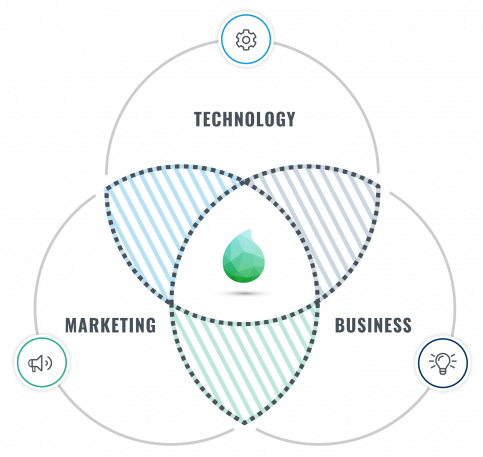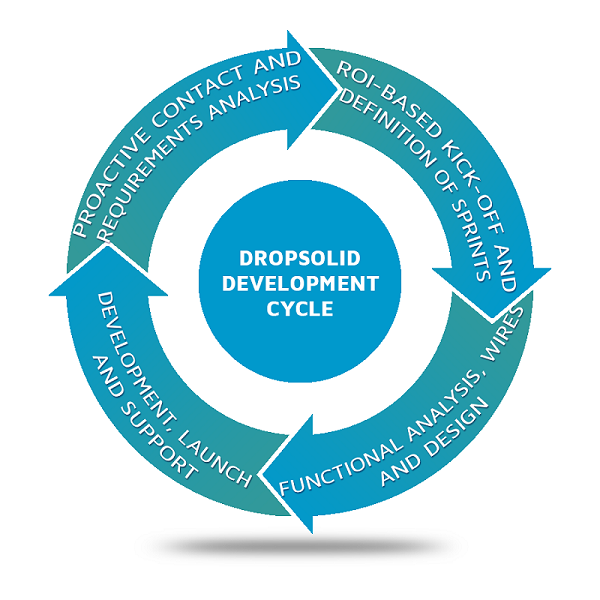
by Dominique De Cooman, Dropsolid, Gent, Belgium
Developing a digital experience as a one-size-fits-all model is not the approach that Dropsolid likes to take for its clients. Instead, we build websites using an agile development model that follows a cyclical, continuous integration approach. In a joint process, we ask our customers what they want, think proactively together, and come up with the best solution that generates the most value. Let me explain how our way of working enables every company to transform and become a digital business company.
The inconvenient truth has long been out: websites have become a commodity business. A lot of perfectly capable Drupal agencies and website builders are suffering in today’s hyper-competitive market. Everyone is perpetually busy with frantic attempts to take their company into the digital realm. Proven business models across all sectors are under severe pressure due to the digital disruption and CEOs are rushing to get neatly designed, decent-looking website platforms up and running in a new-web age. In this heated market, value, time and freedom are a scarce resource. In the long run, however, the value of a website or digitally connected environment does not lie in the click and code, but in the business value of the solution. These days, there’s nothing easier than creating a beautiful website at minimal cost. If the platform behind it is incapable of serving the underlying business goals, the website is completely and utterly useless.
This heated market allows for tremendous opportunities. Most old-school agencies are busy squeezing every last drop out of both their customers’ existing budget and the time of their developers. It does not require a visionary mind to realize that this will eventually lead to rack and ruin – both in terms of human capital and quality of the solutions delivered. At Dropsolid, we do things differently and create freedom time for our teams. This will become clear later. First, allow me to compare the old-school way of web development to the new way of creating digital experiences.

Transitioning to agile development
Consider the classic request for proposal (RFP) model, which has a rather straightforward explanation. Internal stakeholders sit together to define business requirements and, subsequently, agree on concrete features of the desired solution(s). Some of the larger organizations bring external consultants to the table to help define some of the required capabilities but this is not always the case.
The next step is a closed or public fixed-price RFP to potential vendors, organized by the presales or central purchasing department. The final vendor selection is usually heavily price-based, completeness of the supplier’s response – matching every request – and, sometimes, a demo of the proposed solution. A typical RFP track looks like this:
- Perceived need > RFP > 1-on-1 response
- Price-based vendor selection > fixed-price kick-off > analysis
- Wireframes and design > development > theming > training
- Launch > support.
This seems to make perfect sense at first sight. Both the responsibilities and budget are clear from the outset. The bulk of the work for web development companies lies in matching the required capabilities with the web development company’s expertise and offerings. Counterintuitively though, these kinds of projects do not provide enough value per euro invested. Even worse: they allow the integrator or agency to remain passive and they transfer the majority of the risk and responsibility to the buyer.
How so?
Very often there is a disconnect between the perceived and actual required capabilities of organizations. In layman’s terms: companies usually don’t know what they need. Fixed-price RFPs are both the simplest and the hardest thing: X will be provided by Y date for Z price. At Dropsolid, we like to challenge this, because we believe that fixed-price RFPs generate less business value per euro invested. Rigorous advance planning and a feature-heavy focus hardly ever lead to a cost-efficient, return-on-investment (ROI) sensible solution in the long run. That is why we are geared towards a different way of working, according to the following (simplified) model, as illustrated in the visual below.
This follows a cyclical, continuous integration approach:
- Contact companies before they have realized the issues themselves
- Requirements analysis or transformation/business scan
- Presales phase: more oriented towards potential ROI calculation
- Project kick-off, first sprints based on must haves
- Functional and technical analysis
- Wireframing and subsequent design
- Development, theming, and user training
- Launch
- Support
- Go back to step one and repeat if necessary!
We did not devise this seemingly lengthy, circular approach to appear different or justify charging more (which we don’t do anyway). We build websites using the Dropsolid agile development model because we learned the hard way. Businesses have business problems, and that is why we are here to solve them together. We do not only ask our customers what they want, we try to think proactively and come up together with the best solution that generates the most value. In the founding years of Dropsolid, we sometimes made the mistake of going along with our client’s wishes too much, because they seemed to know perfectly what they needed. Occasionally they were right, more often they weren’t.
Web development used to be easy. Not anymore. Organizations no longer need websites, they need far-reaching digital experiences. End customers are increasingly expecting – not just demanding – a smooth, unified experience across all channels. Good luck trying to do this with a disconnected web platform – it simply won't do.
Agile development model
It’s all about building the right things that will have the most impact on your business. This is an inherently different approach than digital agencies take. They will build just the website that you ask for, with a heavy focus on the marketing side of things. Something they are usually pretty good at. Which is why we prefer to collaborate with them on large projects, rather than fighting them. On the other side of the market, however, you find the pure website integrator. They will focus on the specs and rely mostly on the client for generating ideas about adding business value and how they tie in with digital transformation and digital industrialization.
Our agile approach allows us to build and adapt our products, which often – if not always – results in a better overall solution for our customers. We have now built plenty of solutions for the most common business problems, so we can share the development costs over multiple customers. A digital business company implies a complete and aligned vision in strategy, service, and products. With the goal always being more value for the customer. The golden combo of standardized and custom capabilities allows for a faster time-to-market and agile way of working, so business can stay in the driver’s seat. The agile way of working, allows for a counterintuitive conservative way of spending.
Talking numbers, internally we keep a tight check on things through our extensive managing and reporting tools. Our multisite platform, for example, will be a next step. The teams get time to think, time to build, and the freedom to create and build new things. Our customers do not pay us for the work of an individual team member – they pay us for the combined experience of the entire team. Our overhead costs ultimately result in extra value for our customers – we better make sure it does, otherwise we'll be out of a job soon. We provide stability, continuity, business value, strategy, and completeness of vision, all under the umbrella of the Dropsolid brand.
So what?
If you've made it this far down my blog post, you might have been suppressing the urge to pull a Mitterand and remark: "et alors?" Well, it's quite simple: this way of working matters to your business too. Our rigorous approach was not designed to make you sign a blank check while mitigating accountability from our end – quite the contrary. By analyzing the business needs and breaking them down into individual items and business epics, our clients can keep a tighter check than ever on our performance. Every single working hour is accounted for and provides actionable results. If something doesn't feel quite right or does not generate the required impact, we simply replace it with something different. And that is, ultimately, where the value lies: generating maximum impact with minimum waste of time, effort, resources, and money. If you disagree, put us to the test: I am confident we will be able to prove you wrong.
This is an edited version of a post that was previously published on the Dropsolid website. View the original here.

